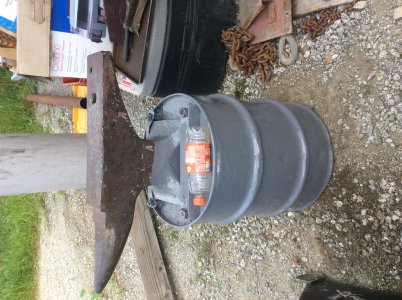Bruce, what a coincidence. Early this morning that thought came to mind. Maybe 5 places. 1/2" allthread. Flatten 2 sides of top of allthread for ease in turning it (no bolt). Turn it into the hole, cut off the allthread sticking up and grind off the remainder. The nickle rod or braze sounds easier though. Actually, bolting and brazing would probably be optimal.
-
Welcome back Guest! Did you know you can mentor other members here at H-M? If not, please check out our Relaunch of Hobby Machinist Mentoring Program!
You are using an out of date browser. It may not display this or other websites correctly.
You should upgrade or use an alternative browser.
You should upgrade or use an alternative browser.
Braze Or Nickle Rod?
- Thread starter SE18
- Start date
- Joined
- Dec 8, 2013
- Messages
- 2,651
It also seems like that would make them *more* suitable as anvils, though you'd still want the steel plate.If the HF anvils have been alloyed into ductile iron, then they could easily be welded with nickel rod made for welding ductile iron.
- Joined
- Dec 8, 2013
- Messages
- 2,651
You mean tap both the plate and the anvil and screw the rod through the plate and into the anvil? That would leave you with no clamping force.Bruce, what a coincidence. Early this morning that thought came to mind. Maybe 5 places. 1/2" allthread. Flatten 2 sides of top of allthread for ease in turning it (no bolt). Turn it into the hole, cut off the allthread sticking up and grind off the remainder. The nickle rod or braze sounds easier though. Actually, bolting and brazing would probably be optimal.
- Joined
- Nov 23, 2014
- Messages
- 2,608
I'd clamp the plate and anvil together and drill the tap holes. Then drill clearance/countersunk holes in the steel plate, tap the anvil. If the bolts don't hold you can still braze the plate to the anvil.You mean tap both the plate and the anvil and screw the rod through the plate and into the anvil? That would leave you with no clamping force.
Bruce
The cast iron only causes a problem when you are hitting cold metal or using edge techniques. The worst thing is drawing a taper on a heavy bar at the far edge. Use a fuller or just weld in an insert at the far edge. Hardy bottom tools can take a lot of the workload off the edges of the anvil. There are centuries of ancient Chinese blacksmithing history about using cast iron anvils. First, their cast iron was "better". Second, they used bread loaf shaped anvils that did not really have real edges, and all the edge techniques were done with hardy tools in the hole. Sometimes, this style of working is referred to as "going Chinese", and it is a perfectly valid style of blacksmithing.
- Joined
- Dec 8, 2013
- Messages
- 2,651
You probably also want to drill fairly deeply into the anvil and use reduced shank bolts so that you can get some stretch.I'd clamp the plate and anvil together and drill the tap holes. Then drill clearance/countersunk holes in the steel plate, tap the anvil. If the bolts don't hold you can still braze the plate to the anvil.
Bruce


